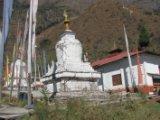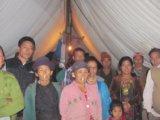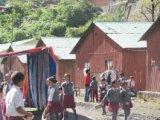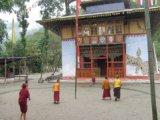Archives
HIMALAYAN RESILENCE
A four hour long grueling drive along the 68 km Gangtok - Mangan stretch gets one to this non-descript remote village. The vehicle has to negotiate carefully through heaps of boulders and sinking zones to avoid mishap. Excavators and General Reserve Engineering Force (GREF) workers busy repairing the road are stark reminders of the earthquake and the cracked hills all along the route are a testimony of the massive work they had to undertake to reopen the road and make it motorable by removing large volumes of debris at several locations due to unprecedented landslides triggered by the devastating tremor. Life in rural Sikkim is slowing returning to normal but the family of 60 year old Budhiram Limbu and eight other families are still living in tents in Ralak village and are yet to come to terms.
It took Limbu and his parents the efforts of their entire life to construct the three storied building, the village Fair Price Shop that he owned and to raise an agricultural farm on his five acres of land. However, it took only a few seconds for the earthquake to reduce all of this to rubble and thereby render the family homeless, forcing them to live under tarpaulin sheets for an uncertain period of time. Budhiram was too traumatized to narrate his woes. Only his family members and villagers narrated the sequence of events.
| For the people living in the worst hit areas of North District including Chungthang, Dzongu, Lachung, Lachen that are remotely and strategically located as well as other places like Nandok village in East District - conditions are still appalling |
Among the camp residents was Momaja Limbu, a widow and head of a four member family, who is still haunted by the trauma of the devastation. “It was around 6.15 pm. We were preparing the evening meal. All of a sudden we felt a massive shaking of earth coupled with deafening sounds of landslides atop the hills. As we ran away in fear for our lives, we could see some of the houses falling down in front of our eyes. Thus, a disaster that lasted for a few seconds has forced us to the streets,” she narrates.
Ralak villagers are part of the 53,172 families identified by the Sikkim government in the entire state, whose houses have either collapsed or been damaged in the earthquake. The government opened 53 relief camps immediately to provide shelter to these families. The tremor claimed 77 innocent lives, damaged 642 school buildings apart from individual houses and office buildings. The state government served evacuation notices to occupants of 57 buildings rendered unsafe by the tremor.
In the North District, the most affected among the four districts of the border state by the earthquake, the district administration has identified 258 Pucca houses as totally collapsed; 1,256 as severely damaged; 528 as major damaged and 377 as minor damaged. It has also identified 326 Kutcha houses as totally collapsed; 3,720 as severely damaged, 242 as major damaged and 413 as minor damaged. `12,56,42,000.00 has already been disbursed till November 10th for the victim families for construction and repairing of houses, claimed Mr. S.S. Rawat, Deputy Director, Relief and Rehabilitation North District. Out of the 258 Pucca houses which have collapsed in the district, 221 are in Chungthang sub-division alone, he said.
T he relief and rehabilitation efforts by the district administration in collaboration with the Army, Indo Tibetan Border Police (ITBP), the authorities of a number of Hydro Electric Power projects including the Teesta Urja Limited and NHPC, NGOs, Red Cross Society among others provided some aid and helped the quake hit families to start rebuilding their lives.
he relief and rehabilitation efforts by the district administration in collaboration with the Army, Indo Tibetan Border Police (ITBP), the authorities of a number of Hydro Electric Power projects including the Teesta Urja Limited and NHPC, NGOs, Red Cross Society among others provided some aid and helped the quake hit families to start rebuilding their lives.
However, for the people living in the worst hit areas of North District including Chungthang, Dzongu, Lachung, Lachen that are remotely and strategically located as well as other places like Nandok village in East District - conditions are still appalling and many like Budhiman Limbu are yet to recover from the trauma.
For the Pucca houses category, the State Government has given compensation of `50,000 for collapsed houses, `25,000 for severely damaged houses, `15,000 for major damaged houses and Rs 5,000 for partially damaged houses. In the Kutcha house category it has sanctioned `30,000 for collapsed houses, `15,000 for severely damaged houses, `6,000 for major damaged houses and `3,000 for partially damaged houses. It is also coming up with an assessment of the damage to religious institutions for sanction of financial assistance soon. However, most of the victim families complained that the amount was too little as compared to the sky rocketing prices of building materials.
| Ralak villagers are part of the 53,172 families identified by the Sikkim government in the entire state, whose houses have either collapsed or been damaged in the earthquake. |
“In Magnan, the headquarters of North District a bag of cement costs `370, and a piece of brick costs `10. We are also facing shortage of construction workers as they fled the state following the earthquake and are yet to return,” said Lengdup Lepcha, President of Chungthang Panchayat. Chungthang which is 28 kms from Mangan.
In some places of South District, the devastation has been such that affected families will now have to be relocated to new sites as the plots of land on hill slopes on which their houses stood have also caved in due to the massive landslides triggered by the earthquake. Altogether 71 such families need immediate shifting from their original places and relocation to new sites, said Information and Public Relations and Rural Management and Development Department Minister Mr. C.B. Karki. For villagers of Bay in Dzongu which is a restricted and protected zone in North District which is dominated by the Lepcha tribe, the issue is more serious as a hill above the village came crashing down on it due to the earthquake and buried half of the village under the rubble of the landslip. Seven villagers were instantly killed and the bodies of two such victims are yet to be recovered. The village is abandoned now and the road connectivity is yet to be re - established.
Psychological counseling to overcome the trauma:
 A strong community bond among the various communities as well as spiritual counseling given by the elder monks of the Buddhist monasteries in absence of professional psychological experts helped the affected villagers to overcome the trauma to a large extent. This provides an opportunity for the Sikkim Government and other Northeastern states prone to such disasters to institutionalise such traditional healing mechanisms. In some places, community leaders have volunteered to share their own houses to provide shelter to families rendered homeless by the quake.
A strong community bond among the various communities as well as spiritual counseling given by the elder monks of the Buddhist monasteries in absence of professional psychological experts helped the affected villagers to overcome the trauma to a large extent. This provides an opportunity for the Sikkim Government and other Northeastern states prone to such disasters to institutionalise such traditional healing mechanisms. In some places, community leaders have volunteered to share their own houses to provide shelter to families rendered homeless by the quake.
The Panchayat Secretary of Passingdang, Mr. N Neema Lepcha, preferred to shelter 19 victim families of his community people of Bay village in his own house rather than asking them to take shelter in relief camps. In Lachung, all Lachungpas (inhabitants of Lachung) gathered in Lachung Monestry and took shelter for 15 days. The Nanak Lama Sahib Gurudwara of 30 Assam Rifles in Chungthang was instrumental in providing food and accommodation to thousands of local people as well as outsiders working as migrant workers, most of whom have fled the state in fear for their lives in the aftermath of the quake and several aftershocks.
Restoration of Education:
| Mr. Sonam D Bhutiya, Joint Director of Human Resource Development department, North District attributed the restoration of education immediately after the devastation as one of the major achievements in the process of rebuilding in the quake hit state. |
Mr. Sonam D Bhutiya, Joint Director of Human Resource Development department, North District attributed the restoration of education immediately after the devastation as one of the major achievements in the process of rebuilding in the quake hit state. Altogether 81 government school buildings of the district have been recommended for major and minor repair work. Either temporary sheds have been constructed for all such schools or the school children have been incorporated in other government schools. Some private school buildings, totally damaged in Chungthang sub-division continued education immediately in shifting arrangements. The Moonlight High School for instance, has been shifted to the Indo - Tibetan Border Police (ITBP) camp in Chungthang which allowed them to run the school in their camp for the current academic year.
Restoration of Road Connectivity:

As human suffering has crossed all the limits and some of the most devastated villages including Bay in Dzongu still remained cut off, restoration of road connectivity has become a major challenge for both the Public Works Department authorities and Border Roads Organisation (BRO) in charge of maintenance of highways and state roads. “We counted 81 landslides between Rang Rang area and Chungthang, which is only a 38 km stretch in North District. There were continuous hill slippages over a stretch of three kms and land formation completely washed away by landslides in an area of 10 meters” said Mr. Sunil Kumar, BRES, EE(C) of General Reserve Engineering Force (GREF), an umbrella organisation of Border Roads organisation (BRO) which is in charge of construction and maintenance of the roads between Rangrang and Chungthang. Two junior engineers of GREF succumbed to injuries when a massive landslide hit their bus which was carrying 17 GREF staff from Chungthang on that fateful evening.
Ongoing construction work, repairing and restoration activities of roads is visible everywhere. However, the local villagers are annoyed by the slow pace of work and feel that the BRO needs to adopt modern technologies and equipment to build strong, all weather roads along the fragile hill curves. The road construction also lacks a proper drainage system which is crucial in such fragile and rugged terrain.

A ‘Reconnaissance Report’ compiled by Dr. Manoranjan Mishra and Dr. Bimal Kumar Ghimire of Sikkim University which is the result of a study of a team of experts and students of the Central University that visited the earthquake hit areas and carried out a preliminary investigation states, “Another problem of this area is the drainage pattern, the maximum stream including the main river Teesta is flowing in the opposite direction of the bedding inclination. So the chance of water percolation is higher and this besides frequent waterfalls makes this region more unstable. The magnitude, intensity and frequency of Himalayan landslides of all types and sizes occur in almost all types of rocks and quaternary formations of Sikkim. North Sikkim is especially affected by landslide due to the combination effect of landform, drainage pattern, rock type, structural elements and obviously this problem has been enhanced by tremors of several aftershocks.”
Despite such concerns, the ongoing road construction and restoration projects lack the component of a drainage network. This has put a question mark on the capacity of the BRO and other agencies and the effectiveness of the technologies they are using for construction of a proper road network in this mountainous state.
The future:
The state government has decided to incorporate into the earthquake rehabilitation plan the ambitious Chief Minister’s Rural Housing Mission (CMRHM). This housing scheme under which `5 lakh was originally meant for poor people with the objective of replacing all kutcha houses with pucca houses by 2015 will now also cover families severely hit and rendered homeless by the quake. “The CMRHM is a unique housing scheme for poor people that we have taken up during this financial year and 6000 such houses have been identified under the scheme. But as the tremor left thousands of people homeless, we have decided to add another 10,000 such families. Construction activities would resume within three months of the earthquake,” said the IPR and RMDD Minister. The `5.69 lakh cost per house scheme is for a single floor earthquake proof house with provisions for another floor in future. Funds from Indira Awas Yojna are also to be incorporated in the scheme, he added.
As a long term measure, to ensure human security and balanced development activities, Mr. T. W. Lepcha, MLA of Lachen - Mangan constituency has asked the Department of Mines and Geology in Gangtok to conduct a ‘Vulnerability and Stability Mapping’ of his constituency area which includes Lachung, Lachen and Chungthang, the worst hit areas of North District. “The Department has submitted its preliminary report and I have already placed it before the Chief Minister. The entire process which will involve around `35 lakh will take a few months to complete,” said Mr. Lepcha. He added that the State Government too has decided to urge the Centre to undertake similar initiatives in the entire state so that areas best suitable for human habitation can be identified and planned accordingly in the coming days. The report compiled by Sikkim University has suggested for “constant multi - pronged backup policy programs to assist them economically, socially and physically to develop their resilience to cope with future disasters of similar and higher intensity in nature.” It also recommended that sensitization and capacity building of human resources at all levels and the creation of suitable and effective institutional mechanisms may be integral components of the road map for steering the state towards seismic safety.

